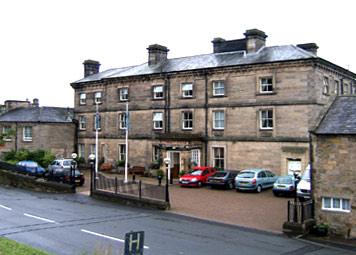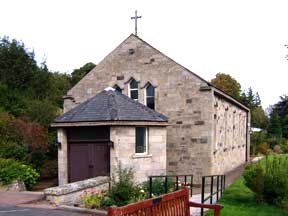Rothbury House
Rothbury
House is situated to the west end of the village and is now owned
and managed as a convalescent home by the Royal Air Forces Association.

Known locally as the "County" it was originally named "Rothbury Hotel" and
opened in 1789 as a private hotel catering to the large number of visitors to
the area.
When it
was sold by public auction at the Turks Head Hotel, Newcastle in 1880, it
was described as:
"The most magnificent building of its kind in the North of England, displaying the high genius of the architect in beauty of design and solidity of structure, affording in its splendid public, reception, and private rooms, all the luxurious comfort which the palatial residence of the nobility can offer. Standing on a commanding eminence, within its own Pleasure Grounds and Gardens, its boundaries washed by the crystal stream of the far-famed River Coquet, with the bold outlines of the Simonside Hills towering rugged and high over a fertile valley. Stabling, Coach Houses, and every other convenience."
And
".... splendid public rooms, viz.: Two Dining Rooms (convertible into one), 28ft by 16 ft each, with marble fireplaces, ornamental cornices; Billiard Room, 26 ft by 18ft; Library and Coffee Room and Drawing Room of similar size; numerous Sitting and Bed Rooms, en suite; Smoke Rooms, Kitchens, Sculleries, Butler's Pantry, Servants' Hall, Larders, and Store Rooms, and splendid Cellarage. The entire accommodation numbers upwards of 60 apartments.
It is worth noting that
the auctioneer at this sale was Samuel Donkin & Sons, founder of the Rothbury
Auction mart. The price was £5,700 and the buyer was Mr. Robert Muckle.
Robert Muckle.
Directly opposite is the Roman Catholic Church on Gravelly Bank, once the main road to Thropton. The church is now open again following substantial repairs to the roof. The diocese considered closing the church permanently due to the high cost of repairs and the dwindling number of attendees. One parishioner offered to fund the whole cost and his sentiments were echoed by many in the village who promptly pledged donations for the repairs.
Before continuing the circular tour of the village you might like to take your life in your hands and stroll along the road to Thropton. A hundred yards past Rothbury House is a path leading down to the river. This is Beggar's Rigg Car Park with a few pleasant places to sit, picnic and watch the river.
Beggars Rigg itself
comprises the green slope north of the main Rothbury to Thropton road. There are
a number of derivations of the name but according to Dippie Dixon the real
origin is to be found in the term 'Big rig' where 'big' is a coarse barley grown
in former years. Chambers dictionary includes this word spelled as 'bigg'.
Tomlinson who wrote the definitive 'Guide to Northumberland' in 1888
quotes it as being a place where 'mendicants in the olden time waited to be
admitted to the town'. And in a time of great scarcity during the 17th century
the poor were allowed to pluck the peas which grew on the ridge. No peas grow
there today and the steep hillside is used to graze sheep.
Just across the main road was a vantage spot from which to view the
Rothbury races earlier this century. The races were discontinued in 1965
after some two hundred years of steeple chasing and turned into a nine hole golf
course before finally expanding into a full 18 hole course.
Today this erstwhile vantage point is part of a network of walks and a
place where those with metal detectors still manage to find
the occasional coin from the racing days.
This is the end of the village and it is time to cross the road and passing the original Congregational Church
continue down the High Street